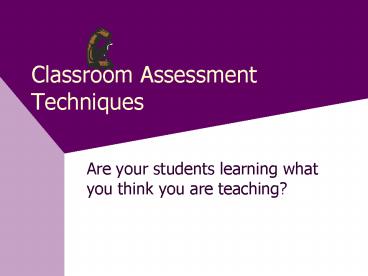Classroom Assessment Techniques - PowerPoint PPT Presentation
1 / 22
Title:
Classroom Assessment Techniques
Description:
To provide an introduction to classroom assessment ... Misconception/Preconception check. Double Entry Journals. Empty Outlines. Minute Paper ... – PowerPoint PPT presentation
Number of Views:2066
Avg rating:3.0/5.0
Title: Classroom Assessment Techniques
1
Classroom Assessment Techniques
- Are your students learning what you think you are
teaching?
2
Objectives
- To provide an introduction to classroom
assessment - To provide participants with examples of many
different styles of classroom assessment
instruments based on teaching goals - To give us all an excuse to talk more about
teaching and learning!
3
Classroom Assessment is an approach designed to
help teachers find out what students are learning
in the classroom and how well they are learning
it.
4
How is Classroom Assessment Different?
- It is aimed at course improvement, rather than at
assigning grades. - Primary Goalunderstand student learning to
improve teaching
5
Classroom Assessment is Based on Seven
Assumptions
- The quality of student learning is directly,
although not exclusively, related to the quality
of teaching.
6
Classroom Assessment Assumptions
- To improve effectiveness, teachers need first to
make their goals and objectives explicit and then
to get specific, comprehensible feedback on the
extent to which they are achieving those goals
and objectives.
7
Classroom Assessment Assumptions
- To improve their learning, students need to
receive appropriate and focused feedback early
and often they also need to learn how to assess
their own learning.
8
Classroom Assessment Assumptions
- The type of assessment most likely to improve
teaching and learning is that conducted by
faculty to answer questions they themselves have
formulated in response to issues or problems in
their own teaching.
9
Classroom Assessment Assumptions
- Systematic inquiry and intellectual challenge are
powerful sources of motivation, growth, and
renewal for college teachers, and Classroom
Assessment can provide such challenge.
10
Classroom Assessment Assumptions
- Classroom Assessment does not require specialized
training it can be carried out by dedicated
teachers from all disciplines.
11
Classroom Assessment Assumptions
- By collaborating with colleagues and actively
involving students in Classroom Assessment
efforts, faculty (and students) enhance learning
and personal satisfaction
12
Characteristics of Classroom Assessment
- Learner Centered
- Teacher-Directed
- Mutually Beneficial
- Formative
- Context-Specific
- Ongoing
- Rooted in Good Teaching Practice
13
Classroom Assessment is a way to gather
information on what we do
- In our classrooms
- With our students
- With our subject matter
- With our teaching styles
- With all the constraints we have on our time and
energy
14
Why should I use CATs?
- For Faculty, CATs can
- provide short-term feedback about the day-to-day
learning and teaching process at a time when it
is still possible to make mid-course corrections - provide useful information about student learning
with a much lower investment of time compared to
tests, papers, and other traditional means of
learning assessment. - Help to foster good rapport with students and
increase the efficacy of teaching and learning. - Encourage the view that teaching is a formative
process that evolves over time with feedback.
15
Why Should I Use CATs?
- For students, CATs can
- Help them become better monitors of their own
learning. - Help break down feelings of anonymity, especially
in larger courses. - Point out the need to alter study skills.
- Provide concrete evidence that the instructor
cares about learning.
16
Classroom Assessment helps us
- Focus on learning
- Define what is important in our teaching
- Gather information on what we do
- Determine ways to be even more successful at our
teaching - Discuss teaching and learning with our colleagues
from a base of data - Clarify how different teaching strategies relate
to our specific course objectives
17
Classroom Assessment addresses questions such as
- Are my students learning what I think I am
teaching? - Who is learning and who is not learning?
- What am I doing that is useful for these
students? - What am I doing that is not useful for these
students?
18
Classroom Assessment instruments are
- Easy to design
- Easy to administer
- Easy to cull information from
- Designed to involve students in their own
learning - Easy to revise
- Not intended to be statistically valid or reliable
19
HOW DO I DO THIS?
20
Five suggestions for a successful start
- If a Classroom Assessment Technique does not
appeal to your intuition and professional
judgment, dont use it. - Dont make Classroom Assessment into a
self-inflicted chore. - Dont ask your students to use any CAT you
havent previously tried on yourself. - Allow for more time than you think you will need
to carry out and respond to the assessment. - Make sure to close the loop. Let students know
what you learn from their feedback and how you
and they can use that information to improve
learning.
21
Sample CATS
- Assignment Assessments
- Background Knowledge Probe
- Pro and Con Grid
- Invented Dialogues
- Student-Generated Test Questions
- Profiles of Admirable Individuals
- Chain notes
- Misconception/Preconception check
- Double Entry Journals
- Empty Outlines
- Minute Paper
- One Sentence Summary
- Productive Study-Time Logs
- Directed Paraphrasing
22
This has been CATS































